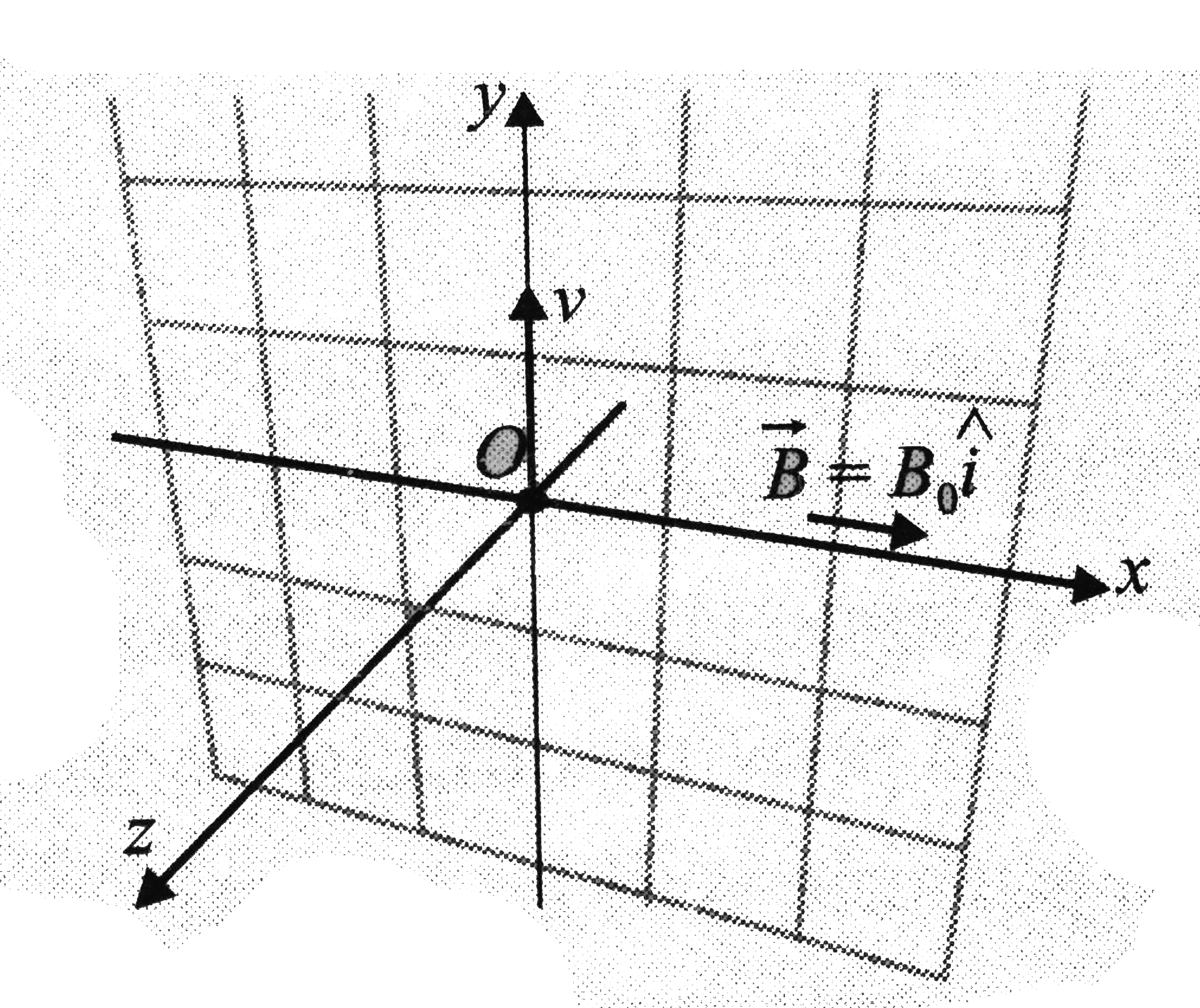A particle of mass m and charge q is moving in a region where uniform, constant electric and mangetic fields →Eand→B are present. →Eand→B are parallel to each other. At time t=0, the velocity →v0 of the particle is perpendicular to →E (Assume that its speed is always <<c, the speed of light in vacuum). Find the velocity →v of the particle at time t. You must express your answer in terms of t,q,m, the vector →v0,→E and →B and their magnitudes →v0,→E and →B.
Because the forces to parallel electric and magnetic fields on a charged particle moving perpendicular to the fields will be at right angles to each other ( electric force being along the direction of →E while magnetic force perpendicular to the plane containing ¯v and ¯¯¯B) so magnetic force will not affect the motion of charged particle in the direction of electric field and vice- versa. So the problem is equivalent to superposition of two independent motion as shown in the figure.
So for motion of the particle under electric field alone.
ay=qEmi.e.,dvydt=qEm
or ∫y0dvy=∫t0dvy=∫t0qEmdt i.e.vy=qEmt.........(1)
While at the same instant , the charged particle under the action of magnetic field will describe a circle in the x−z plane
With r=mv0qBi.e.,ω=v0r=qBm
So angular position of the particle at time t in the x−y plane
will be given by θ=ωt=qBmt and therefore in accordance with figure.
and
vz=v0sinθ=v0sinωt=v0sin(qBm)t..................(3)
So in the light of equations (1),(2) and (3) , we get
→v=ˆivx+ˆjvy+ˆkvz
→v=[v0cos(qBm)t]ˆi+(qEm+)ˆj+(v0sin.qBm+)ˆk
But because here, ˆi=→v0v0,ˆj→EE=→BB And
ˆk=¯vׯ¯¯Bv0B
So
¯v0=(¯v0v0)v0cos(qBtm)+(→EE)qEmt+(→v0×→Bv0B)v0sin(qBmt)
Topper's Solved these Questions
- MOVING CHARGES AND MAGNETISMBook:NARAYNAChapter:MOVING CHARGES AND MAGNETISMExercise:Level =I (H.W)
Explore 42 Videos
- MOVING CHARGES AND MAGNETISMBook:NARAYNAChapter:MOVING CHARGES AND MAGNETISMExercise:Level -II (H.W)
Explore 37 Videos
- MOVING CHARGES AND MAGNETISMBook:NARAYNAChapter:MOVING CHARGES AND MAGNETISMExercise:LEVEL-V (SINGLE ANSWER QUESTION)
Explore 85 Videos
- MAGNETISM AND MATTERBook:NARAYNAChapter:MAGNETISM AND MATTERExercise:EXERCISE - 4 (SINGLE ANSWER TYPE QUESTION)
Explore 17 Videos
- NUCLEAR PHYSICSBook:NARAYNAChapter:NUCLEAR PHYSICSExercise:LEVEL-II-(H.W)
Explore 9 Videos
Similar Questions
Knowledge Check
A particle of charge q and mass m starts moving from the origin under the action of an electric field →E=E0ˆi and →B=B0ˆi with a velocity →v=v0ˆj. The speed of the particle will becomes √52v0 after a time
Amv0qE0Bmv02qE0C√3mv02qE0D√5mv02qE0
A particle of mass m and charge q is moving in a region where uniform electric field −−→E and and uniform mag-netic field −−→Bare present. It is given that −−→E∣∣→E∣∣=−−→B∣∣→B∣∣. At time t = 0, velocity of the particle is −−→V0 and −−→V0.−−→E=0. Write the velocity of the particle at time t.
View SolutionAn electric field (vec E) and a magnetic field (vec B)exist in a region . The fields are not perpendicular to each other.
View SolutionIf ∣∣→a+→b∣∣=∣∣→a−→b∣∣, show that the vectors →aand→b are perpendicular to each other.
View SolutionA particle having mass m and charge q is released from the origin in a region in which electric field and megnetic field are given by →B=−B0ˆj and →E=→E0ˆk. Find the speed of the particle as a function of its z-coordinate.
View SolutionIf →a+→b+→c=→0, −→|a|=3, ∣∣→b∣∣=5 and |→c|=7.
Find the angle betweeen →a and →b
View SolutionA charge particle of mass m and charge q is projected with velocity v along y-axis at t=0.

Find the velocity vector and position vector of the particle →v(t)and→r(t) in relation with time.
View SolutionTwo vectors →a and →b are perpendicular to each other if →a.→b=0.
View Solution

